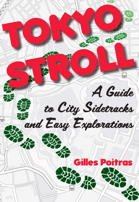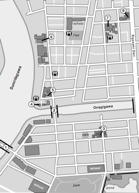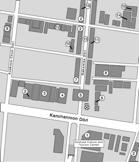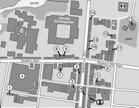











Tokyo Stroll Supplement: Musashino

This page is for locations in the Musashino area of Tokyo. This neighborhood is not part of my book Tokyo Stroll.
For information on Tokyo Stroll and this web supplement see Tokyo Stroll Supplement home page
For users of the Organic Maps, Maps.Me and Google Maps apps the items below have bookmarks you can import into those apps to make navigation easier.
Instructions and links are on the Viewing Locations in Organic Maps, Maps.Me, Google Maps, or Google Earth page.
Some entries on this page may include a note that says "Description to be added soon ." These entries are for items I felt should be listed even if the description is not ready to assist those who wish to plan a trip. When possible I included a link to an official web page, I suggest also doing web searchs for more information.
Musashino Shi (武蔵野市)
Official pages for each of the cities and towns of will have sections of interest to visitors. These will likely be labeled as dealing with culture, tourism, or events.
Musashino Shi official site: http://www.city.musashino.lg.jp
Harmonica Yokochō (ハーモニカ横丁)
A maze like neighborhood in Kichijōji just north of Kichijōji Station that is dense with over 100 small shops, restaurants and izakaya on narrow streets. The entrance on Kichijōji Dōri has a large yellow sign with red letters. This area gets its name from the shops, one after another, looking like the chambers of a Harmonica. After WWII the neighborhood had a black market that continued as a shopping area, in the 1990s it had a revival as younger shop owners contributed to the area. In the evening the daytime shops selling things like fresh fish, pickles, and candy start to close and the nightlife takes over with many drinking places where you can get light food to go along with your sipping.
NEAREST TRAIN/SUBWAY STATION: Kichijōji Station (Chūō-Sōbu Line, Chūō Line (Rapid), Keiō Inokashira Line)
Inokashira Park Zoo (井の頭自然文化園)
A small zoo located in the Musashino portion of Inokashira Park with an impressive selection of animals and displays. There is a special focus on Japanese species such as tanuki, Japanese badger, Japanese flying squirrel, there is even a habitat, the Wildlife Encounter Field, where you can find various local small animals that live there. For little kids of all ages the guinea pig petting zoo is fun. The zoo also contains a sculpture museum where the studio of Seibo Kitamura has been preserved. This museum is in three buildings one of which houses the original model of the Nagasaki Peace Prayer Statue.
NEAREST TRAIN/SUBWAY STATION: Kichijōji Station (Chūō-Sōbu Line, Chūō Line (Rapid), Keiō Inokashira Line)
CLOSED: Monday (closed Tuesday if Monday is a public holiday)
WEB: https://www.tokyo-zoo.net/english/ino/index.html
Kichijōji SUNROAD shopping street (吉祥寺サンロード商店街)
This famous Kichijōji shōtengai, neighborhood covered shopping street, north of Kichijōji Station is about 300 meters (984 feet) long. The shōtengai was created in the 1970s and renovated not long ago with a new roof to allow natural light in. Sunroad is a popular enough attraction that it is listed in many tourism guides. The local community is a diverse one with colleges and plenty of families and this is reflected in the variety of shops in the street. Most shōtengai are one story with perhaps the owners living above, on SUNROAD there are some multistory buildings with shops on several floors. Plus given the length of the road there is room for pretty much any kind of shop or service you can think of. There are also plenty of restaurants so the street operates well into the night when many of the regular shops are closed.
NEAREST TRAIN/SUBWAY STATION: Kichijōji Station (Chūō-Sōbu Line, Chūō Line (Rapid), Keiō Inokashira Line)
WEB: https://sun-road.or.jp/en/
Musashino Clean Center (武蔵野クリーンセンター)
Opened in 1984 as the waste disposal center for Musashino and temporarily closed in 2016. The building was then redesigned to put more of the operation underground, better fit the largely residential neighborhood and reopened in 2017. Part of the redesign was installing solar panels and setting up a vegetable garden with a composting facility. Eco Marche, an environmental festival, is held three times a year with presentations as sell as food and goods sold. Visitors may enter the building and observe some of the processes through windows on the second floor.
NEAREST TRAIN/SUBWAY STATIONS: Higashi-Fushimi Station (Seibu Shinjuku Line), Mitaka Station (JR Chūō Line (Rapid), JR Chūō-Sōbu Line)
CLOSED TO VISITORS ON: Tuesdays, national holidays, if Monday is a holiday they will be open Tuesday but closed Wednesday)
Tsukemono Bar 4328 (漬け物BAR 4328)
Founded 1945 in Harmonica Yokochō. By day this is Shimizuya a shop selling Japanese pickles, tsukemono, at night it changes into Tsukemono Bar 4328 a small bar serving pickles to go with your drinks. I first heard of this bar when I was watching an episode of Tokyo Eye 2020 on NHK World and knew I had to include it in my travel plans. If you are not sure what to get just order the Shimizuya set which gets you a variety plus quail eggs. They also serve other foods like stews. The ground floor has table seating open to the street, upstairs there is a small standing bar for only a few people.
NEAREST TRAIN/SUBWAY STATION: Kichijōji Station (Chūō-Sōbu Line, Chūō Line (Rapid), Keiō Inokashira Line)
Back to the Tokyo Stroll Supplement home page - Privacy Notice - Back to Gilles' home page
Created November 3, 2022 | Content last updated July 29, 2025